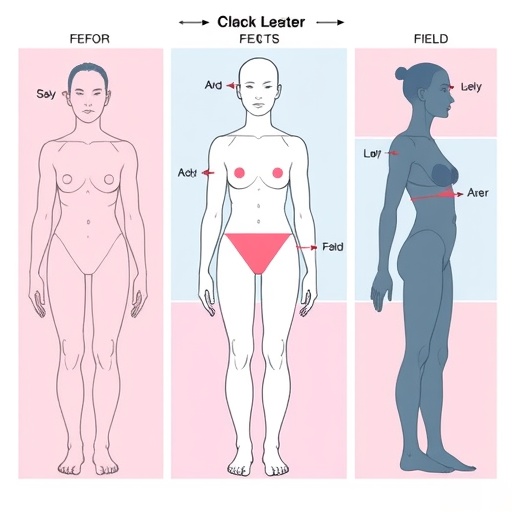In recent years, the healthcare landscape has increasingly recognized the unique needs of transgender and gender-diverse patients. This paradigm shift has paved the way for a new study authored by a team of researchers including Jessica Siegel, Marissa Rieu-Werden, and Sarah Brodney. Their work, slated for publication in the Journal of General Internal Medicine in 2025, intricately examines the use of Anatomic Inventory Fields, a novel approach aimed at improving patient care within this demographic. For many, the mere mention of “anatomy” may evoke a sense of discomfort, but in the context of this research, it signifies empowerment, understanding, and above all, a willingness to evolve the standard practices in healthcare.
The study’s pivotal aim is to enhance the communication between healthcare providers and transgender patients. Effective communication is a cornerstone of quality healthcare, and in cases where gender identity intersects with medical treatment, clarity becomes even more critical. The researchers underscore how conventional medical systems often fail to accommodate the variability and complexity of anatomical presentations in transgender individuals. By utilizing Anatomic Inventory Fields, which systematically categorize various anatomical characteristics, the study seeks to not only identify gaps in existing healthcare practices but also to fill them.
Fundamentally, the research is grounded in the idea that understanding a patient’s unique anatomy can significantly influence diagnosis and treatment. It is not merely an academic exploration; rather, it reflects a pressing social necessity. Transgender and gender-diverse individuals often face unique medical issues that are inadequately addressed by mainstream medical practices. This study intends to create a more inclusive framework that acknowledges and adapts to these unique challenges.
The methodology employed in this study is comprehensive and rigorous. The researchers collected and analyzed data from an academic medical center over several years, striving to incorporate a wide array of patient experiences. Through qualitative interviews and quantitative assessments, the team formulated a strategy that convincingly articulates how Anatomic Inventory Fields can be operationalized effectively. This multilevel approach guarantees that the findings are not only applicable in theory but also practical in real-world settings.
One of the major findings suggests that an understanding of anatomical diversity can lead to better health outcomes. Such knowledge can help healthcare providers create tailored treatment plans that address specific needs rather than relying on generalized practices. For instance, knowledge of a patient’s specific anatomical characteristics can lead to more informed decisions regarding hormone therapies, surgical interventions, and overall reproductive health. Ultimately, this could significantly lower the rates of complications and improve patient satisfaction.
Moreover, the study sharply criticizes the traditional medical frameworks that often overlook or misinterpret the unique health needs of transgender and gender-diverse individuals. The authors revealed how standardized protocols frequently do not capture the necessary nuances, leading to suboptimal care. By challenging these conventional paradigms, the researchers aim to foster a cultural shift within the medical community that prioritizes the individualized care of transgender patients.
Another groundbreaking aspect of this study is its focus on data privacy and patient autonomy. As many healthcare institutions continue to struggle with how to ethically handle sensitive patient information, this research sets a precedent for responsible data management. The investigative team emphasizes the importance of consent and privacy in utilizing Anatomic Inventory Fields, ensuring that patients feel safe and respected throughout their healthcare journey.
Finally, the implications of this research extend beyond transgender health care alone. By establishing a framework that values anatomical diversity and respects individual experiences, the study lays the groundwork for broader applications across various medical specialties. This approach could easily be beneficial for other marginalized populations that also encounter systemic biases within healthcare systems.
In conclusion, the research conducted by Siegel, Rieu-Werden, and Brodney represents a significant advancement in the understanding of transgender health care. By deploying Anatomic Inventory Fields, the team aims to redefine treatment protocols that cater explicitly to the diverse needs of this population. The 2025 publication in the Journal of General Internal Medicine is eagerly anticipated by healthcare professionals committed to fostering inclusivity and understanding in medical practice.
Though the work is still forthcoming, its implications are already being felt across healthcare discussions. There is a growing recognition that to genuinely serve transgender and gender-diverse patients, a shift in approach is necessary. The call for more comprehensive understanding and the need for practical application of findings in clinical settings can no longer be overlooked. As we await more detailed insights from the study, one thing is clear: the future of healthcare relies on unyielding commitment to evolution and inclusivity.
Subject of Research: Anatomic Inventory Fields in Transgender and Gender Diverse Patient Care
Article Title: Use of Anatomic Inventory Fields in a Transgender and Gender Diverse Patient Cohort from an Academic Medical Center
Article References: Siegel, J., Rieu-Werden, M., Brodney, S. et al. Use of Anatomic Inventory Fields in a Transgender and Gender Diverse Patient Cohort from an Academic Medical Center. J GEN INTERN MED (2025). https://doi.org/10.1007/s11606-025-09855-2
Image Credits: AI Generated
DOI:
Keywords: Anatomic Inventory Fields, Transgender Healthcare, Gender Diversity, Patient Care, Medical Research




